Gynecomastia Type 7
Gynecomastia Type 7
Gynecomastia Type 7-Top of areola is below chest fold Extreme Sag
Definition
Extreme breast sag. The top of the areola is below the level of the chest fold.
- Overview of Gynecomastia
- Causes of Gynecomastia
- Ideal male chest
- Joseph T Cruise, MD’s Gynecomastia Philosophy
- 7 Types of Gynecomastia
- 1-Puffy nipple. Breast tissue outside of areola
- 2-Chest angle less than 45 °
- 3-Chest angle 45-60° Mild breast sag
- 4-Chest angle 60-90° Moderate breast sag
- 5-Chest angle greater than 90° Significant sag
- 6-Top of areola is above chest fold. Severe sag
- 7-Top of areola is below chest fold. Extreme sag
- Are You a Good Candidate?
- Benefits of Male Breast Reduction
- Components of Gynecomastia
- Classic Gynecomastia
- Puffy Nipples
- Fatty Gyecomastia
- Saggy Gynecomastia
- Breast Roll
- Prior to Male Breast Reduction
- Male Breast Reduction Anesthesia
- After the Male Breast Reduction
- Recovery from Male Breast Reduction
- Possible Complications
- Gynecomastia Cost and Financing
- Gynecomastia Words to Know
- Gynecomastia Before and After Pictures
Physical Exam
In Type 7 gynecomastia the top of the areola sags below the level of the chest fold.
Gynecomastia Type 7
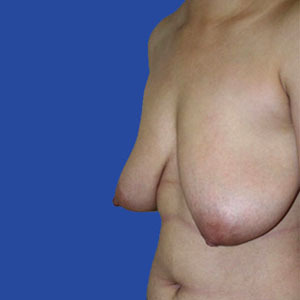
TThe image below outlines the 7 types of gynecomastia. Types 1 is Puffy Nipple. Types 2-5 are determined by the chest angle. Types 6 and 7 are determined by the position of the nipple in relation to the chest fold.
Gynecomastia Types
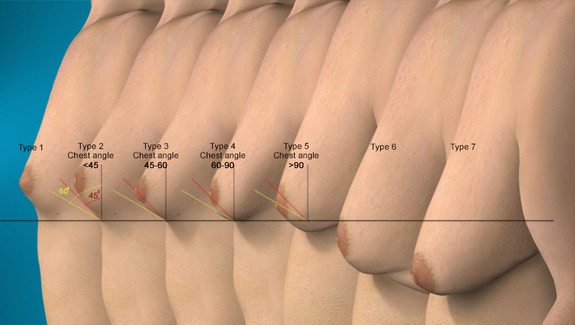
The purpose of categorizing gynecomastia is to determine what type of surgery is necessary to correct a given problem. Joseph T Cruise, MD has developed this classification system based on the extensive work he has done with gynecomastia patients. Other surgeons may use other methods.
Here is how the type of surgery changes depending on the gynecomastia type.
Type 1 – Incision at lower margin of areola
Type 2 – Incision at lower margin of areola
Type 3 – Incision at lower margin of areola or donut lift
Type 4 – Donut lift or anchor lift
Type 5 – Anchor lift
Type 6 – Anchor lift or free nipple graft
Type 7 – Free nipple graft
Unlike Type 6, Type 7 can not be treated with an anchor lift. The nipple and areola simply need to be elevated too much. The blood supply would not be adequate. A free nipple graft is when the nipple and areola are surgically removed and placed in its new position as a skin graft. This means that unlike the anchor lift, the free nipple graft is detached from the body completely and is repositioned as a skin graft.
Surgical implications
- Liposuction
May or may not be useful to remove breast tissue depending on whether or not it is fatty or glandular. If patient is heavy, it may be used to flatten breast roll or decrease fatty deposits at chest margin. - Surgical removal of breast tissue
Surgical removal of breast tissue is often method of choice to ensure that all necessary breast tissue is removed. A significant advantage of the free nipple graft vs an anchor lift is that the surgeon does not need to leave extra volume to make sure the nipple gets a good blood supply. This can be a signficant problem as the tissue gathers like an accordian underneath the nipple. With a free nipple graft, all the breast tissue underneath the areola can be removed leaving a flatter, tighter chest.
Type 7 Gynecomastia
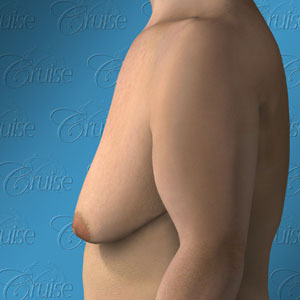
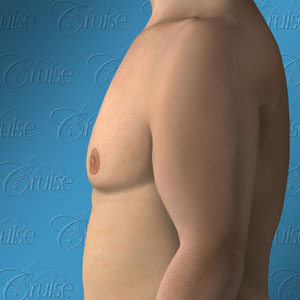
Preferred incision/skin removal for gynecomastia types 1-7
Type 1 – Incision at lower margin of areola
Type 2 – Incision at lower margin of areola
Type 3 – Incision at lower margin of areola or donut lift
Type 4 – Donut lift or anchor lift
Type 5 – Anchor lift
Type 6 – Anchor lift or free nipple graft
Type 7 – Free nipple graft
Incision for Type 7 Gynecomastia
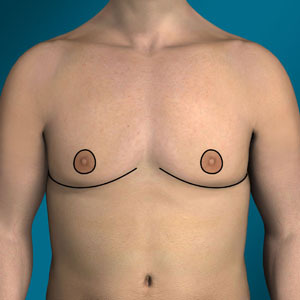
What are the pros and cons of a free nipple graft?
Pros
It has a relatively predictable blood supply that makes a type 6 and type 7 chest lift possible
It allows the surgeon to put the nipple/areola exactly where it needs to be
It allows for a flatter, tighter chest compared to the anchor lift
Cons
There likely will be partial or complete loss of nipple sensation.
There may or may not be a color change of the areola typically making it lighter
There remains a possibility that the areola will still not survive


